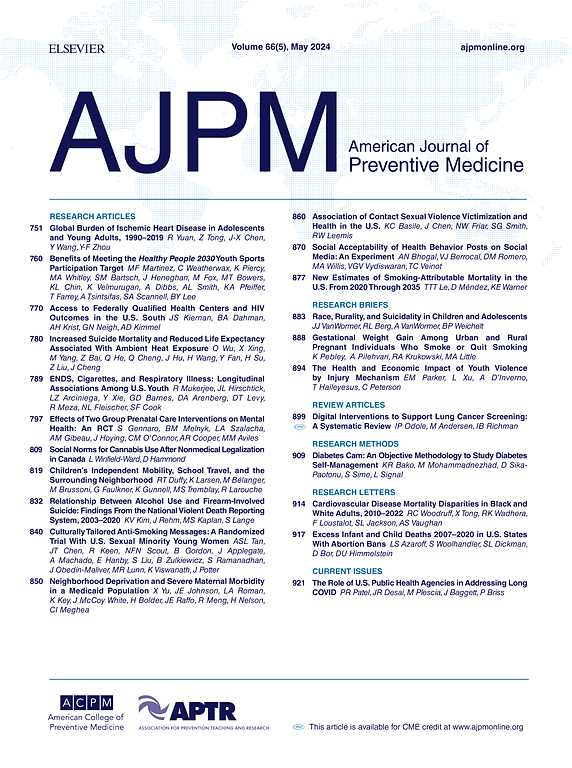不稳定就业类型和精神药物的使用和滥用。
IF 4.5
2区 医学
Q1 MEDICINE, GENERAL & INTERNAL
引用次数: 0
摘要
不稳定就业(PE)已成为工人健康的重要社会决定因素。本横断面研究考察了PE与精神药物使用和滥用之间的关系。方法:对韩国具有全国代表性的8993名年轻工人进行分析。数据收集于2022年进行,本研究的分析于2025年进行。其中包括与就业保障、收入充足、工人权利和保护有关的八项PE指标。采用潜类分析(LCA)对就业类型进行分类。使用比值比和95%置信区间(ci)确定就业类型、精神药物使用和滥用之间的关联。结果:确定了3种潜在的就业类型:标准雇佣关系(SER)型(N=4864; 59.7%)、工具型(N=1973; 20.3%)和不稳定型(N=2156; 19.9%)。精神药物使用报告分别为2.6%、4.7%和6.5%的ser样、工具性和不稳定型个体。精神药物滥用报告分别为0.4%、1.1%和1.4%的ser样、工具性和不稳定型个体。在调整了社会人口学因素后,危险型个体使用精神药物的几率比ser -样型高6.16倍(95% CI: 3.10-12.25),滥用精神药物的几率比ser -样型高10.34倍(95% CI: 1.64-65.39)。结论:体育锻炼经历与韩国年轻工薪族精神药物使用和滥用密切相关。需要采取政策干预措施,以提高就业质量,并确保在这一人群中适当使用精神药物。本文章由计算机程序翻译,如有差异,请以英文原文为准。
Precarious Employment Typologies and Psychotropic Medication Use and Misuse
Introduction
Precarious employment has emerged as a significant social determinant of worker health. This cross-sectional study examined the association between precarious employment and psychotropic medication use and misuse using a typological approach.
Methods
A nationally representative sample of 8,993 young workers in Korea was analyzed. Data collection was conducted in 2022, and the analyses for this study were performed in 2025. Eight precarious employment indicators related to employment security, income adequacy, worker rights, and protection were included. Latent class analysis was employed to classify employment typologies. The associations between employment typologies, psychotropic medication use, and misuse were determined using ORs and 95% CIs.
Results
Three latent employment typologies were identified: standard employment relationship–like type (n=4,864; 59.7%), instrumental type (n=1,973; 20.3%), and precarious type (n=2,156; 19.9%). Psychotropic medication use was reported by 2.6%, 4.7%, and 6.5% of individuals in the standard employment relationship–like, instrumental, and precarious types, respectively. Psychotropic medication misuse was reported by 0.4%, 1.1%, and 1.4% of individuals in the standard employment relationship–like, instrumental, and precarious types, respectively. After adjusting for the sociodemographic factors, individuals in the precarious type had 6.16 times higher odds of psychotropic medication use (95% CI=3.10, 12.25) and 10.34 times higher odds of psychotropic medication misuse (95% CI=1.64, 65.39) than those in the standard employment relationship–like type.
Conclusions
Precarious employment experience is closely linked with psychotropic medication use and misuse among young Korean wage workers. Policy interventions are required to improve the employment quality and ensure appropriate psychotropic medication use in this population.
求助全文
通过发布文献求助,成功后即可免费获取论文全文。
去求助
来源期刊

American Journal of Preventive Medicine
医学-公共卫生、环境卫生与职业卫生
CiteScore
8.60
自引率
1.80%
发文量
395
审稿时长
32 days
期刊介绍:
The American Journal of Preventive Medicine is the official journal of the American College of Preventive Medicine and the Association for Prevention Teaching and Research. It publishes articles in the areas of prevention research, teaching, practice and policy. Original research is published on interventions aimed at the prevention of chronic and acute disease and the promotion of individual and community health.
Of particular emphasis are papers that address the primary and secondary prevention of important clinical, behavioral and public health issues such as injury and violence, infectious disease, women''s health, smoking, sedentary behaviors and physical activity, nutrition, diabetes, obesity, and substance use disorders. Papers also address educational initiatives aimed at improving the ability of health professionals to provide effective clinical prevention and public health services. Papers on health services research pertinent to prevention and public health are also published. The journal also publishes official policy statements from the two co-sponsoring organizations, review articles, media reviews, and editorials. Finally, the journal periodically publishes supplements and special theme issues devoted to areas of current interest to the prevention community.
 求助内容:
求助内容: 应助结果提醒方式:
应助结果提醒方式:


